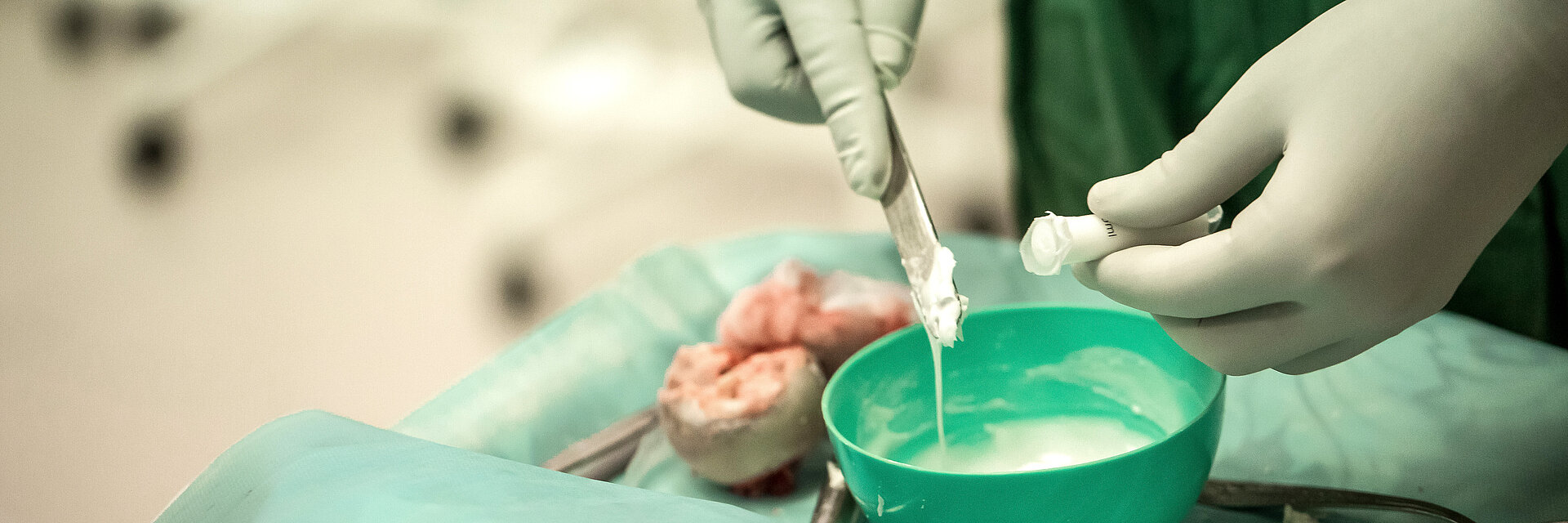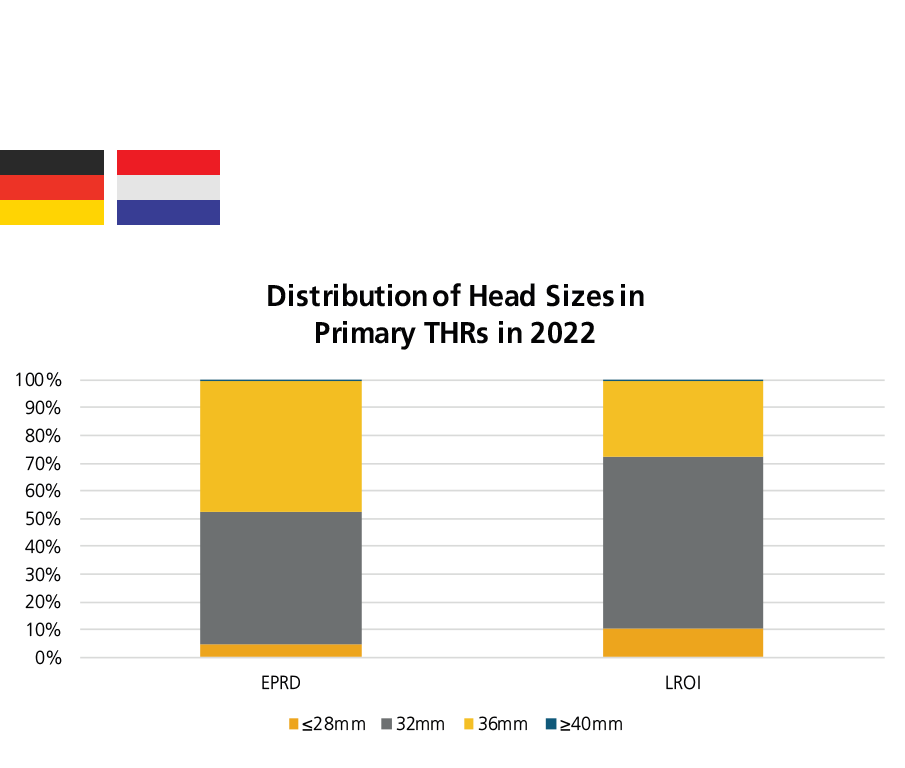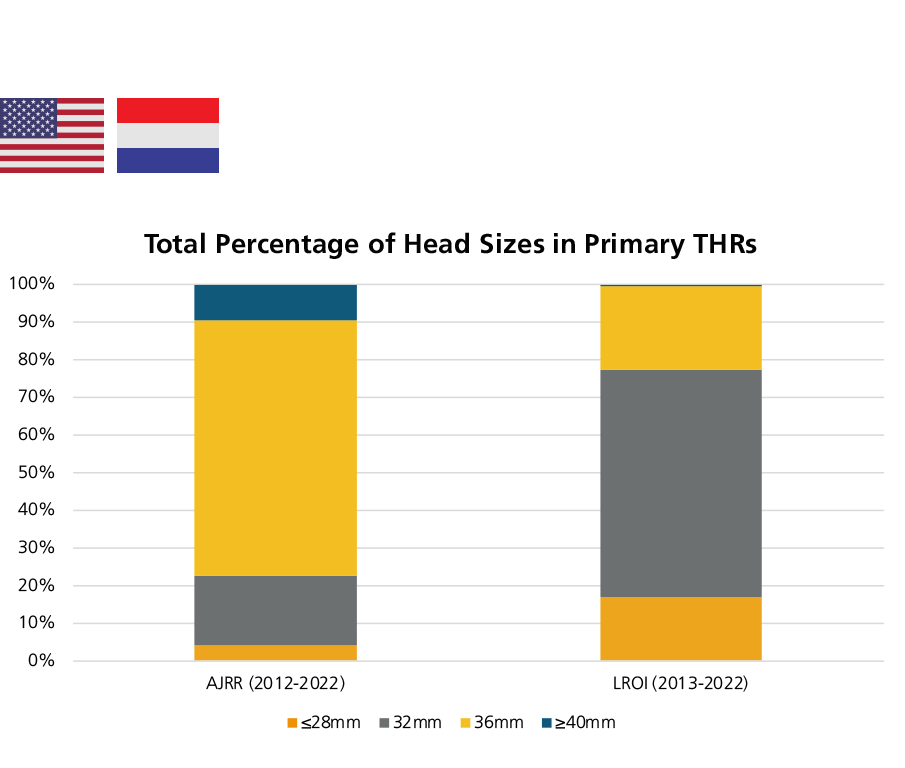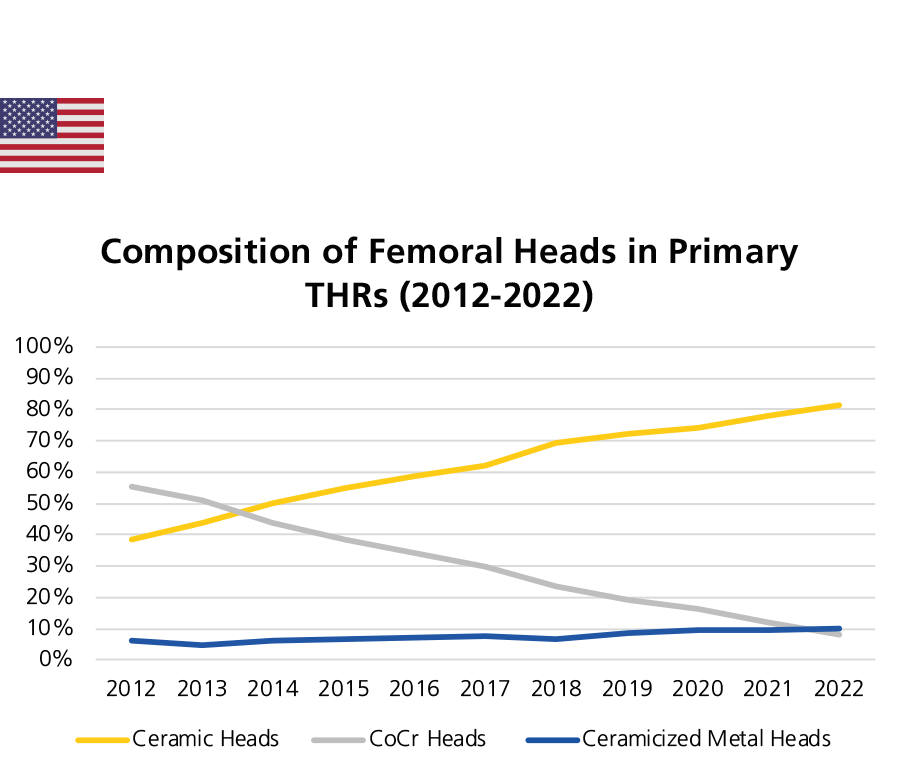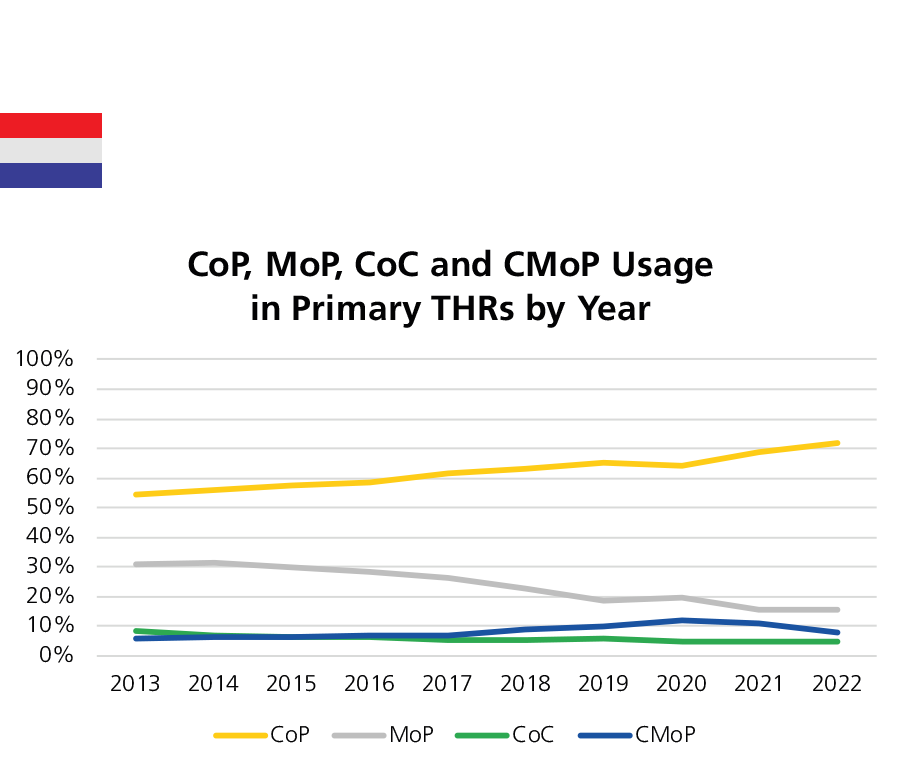Executive Summary
This is the summary of the most relevant information about total hip arthroplasty procedures recorded from seven national arthroplasty registries (NJR, AOA NJRR, EPRD, AJRR, NZJR, SAR and LROI) and presented in the respective annual reports 2023. These seven registries have been chosen, because they have been defined to be the most relevant, in terms of number of procedures annually recorded and/or quality of the data collected and analysed.
Fixation - A trend toward hybrid fixation can be observed in all six national registries except the AJRR. The hybrid fixation is the most popular choice for hip replacement as recorded by the NJR and NZJR. This is the first year that hybrid fixation has overtaken uncemented fixation (45%) as the most used form of fixation in NZJR. When only considering femoral head diameter in THRs, 32mm femoral head is the most common head size according to the considered European registries and NZJR, whereas the AOA NJRR and AJRR report a larger usage of the 36mm heads. There is also a trend towards 36mm femoral heads reported by the NZJR, EPRD and AJRR.
Ceramic - According to annual data, 54.2% of all THRs registered in NJR, 90.4% in EPRD, 27% in SAR, and 75.9% in LROI were performed with ceramic femoral heads. This accounts for an increase of more than 3.2% in NJR, 1% in EPRD, and 3.1% in LROI compared to the usage rates in 2021. The AJRR reported a cumulative data of ceramic femoral heads usage (2012-2022) achieved to 81.4% in 2022, with an 3.4% of increase more than 2021. While SAR declined slightly from 27.2% in 2021 to 26.9% in 2022. The use of CoP bearings has generally increased in 2022. CoP has become the most preferred bearing option of THRs in the NJR, EPRD, AJRR, NZJR, and LROI. The increased use of CoP bearings is mainly on the expense of MoP and CoC bearings.
Dual Mobility - The use of dual mobility bearings has steadily increased over the years both in primary THRs and revision procedures. The NJR is currently the only registry reporting the use of ceramic heads within dual mobility constructs, and about 41% of the total dual mobilities implanted in a primary procedure in 2022 had a ceramic head. The NJR confirms that the CoPoM dual mobility bearings show lower revision trend than the MoPoM combinations, but with no statistical significance. 346 CoC hip resurfacing (MatOrtho ReCerf®) procedures have been documented by the AOA NJRR with a cumulative revision rate of 0.3% (0.0%, 2.1%) at 1 year, and at 3 years (0.3% (0.0%, 2.1%)), with only 1 revision of all 346 procedures, was lower than other MoM resurfacing. Revision rate of 249 CoC resurfacing procedures is recorded by the NJR for the first time in 2022, the early revision rate at 1 year for CoC resurfacing is lower compared to MoM resurfacing at 3 years (1.91% (0.71%, 5.11%) vs. 2.90% (2.74%, 3.06%)) and 5 years (1.91% (0.71%, 5.11%) vs. 5.06% (4.85%, 5.28%)).
Revision - As far as the most common reasons for revision are concerned, (aseptic) loosening, infection, dislocation and (periprosthetic) fractures top the list in varying order. Infection has become the most common reason of all revision procedures in Australia (23.3%) and the United States (22.5%, 2012-2022). Revision rates for infection in other registries have increased year on year.
According to the NJR, the revision rates for CoP bearings remain consistently low or equivalent to those of other bearings up to 18 years. Remarkably, the NJR shows that good results were obtained with CoC and CoP bearings in young patients. The AOA NJRR Annual Report 2023 shows a statistically significant lower rate of revision of CoXLPE in comparison with MoXLPE after 2 years (HR=0.77 (0.72, 0.82), p<0.001). According to the EPRD, CoC had a significantly lower revision rate over the entire period than the other bearings, with the exception of CohXLPE+Antioxidants. Regardless of the fixation method, the NZJR shows that the revision rate for CoC bearings is lower than that for CoP and MoP. The revision rate for CoP is also lower than that of MoP. LROI also shows that CoC had a significantly lower cumulative major revision rate compared to CoP and MoP at 10 years.
General Information of National Joint Registries

Tabel 1: General information of national joint registries.
Evaluation of the data by CeramTec based on the demographic information provided by Annual Reports 2023 of NJR, AOA NJRR, EPRD, AJRR, NZJR, SAR, and LROI.
1 1,364 institutions submitting data to the AJRR from across all 50 states and the District of Columbia are recorded by end of 2022.
* Indicates single year data only generated in 2022.
Total Hip Replacements (THRs) by Fixation
Apart from the AJRR’s classification of fixation methods into uncemented fixation stem group and cement fixation stem group, a clear overall trend towards hybrid fixation can be observed in all six identified national registries.
In Australia, Germany, the United States, and the Netherlands, uncemented fixation is still the most commonly used method. In Sweden, the use of cemented fixation decreased over the years, but still accounts for 52% of all THR procedures.
Hybrid fixation was documented to be utilized in 40.3%, 36.2%, and 51% by NJR, AOA NJRR and NZJR, respectively. Hybrid fixation is the most popular choice for hip replacement, according to the NJR and NZJR. This is the first year that hybrid fixation has replaced uncemented fixation as the most commonly used form of fixation in New Zealand.
In 2022, 19.1% of primary hip replacements recorded in the NJR dataset were cemented fixation, 36.2% were uncemented fixation, and 40.3% were hybrid fixation. The use of cemented fixation in all hips has decreased by almost three times, from 53.5% in 2004 to 19.1% in 2022, while the percentage of uncemented fixation has increased from 18.3% in 2004 to a peak of 44.1% in 2012, then dropped to 36.2% in 2022. The usage of hybrid fixation has more than tripled, from 12.5% in 2004 to 40.3% in 2022.1
In Australia, there is a continuing trend for uncemented fixation to increase from 51.3% in 2003 to 61.9% in 2022. The percentage of hybrid fixation decreased slightly from 36.8% in 2020 to 36.2% in 2022, while the numbers for cemented fixation decreased significantly from 13.9% in 2003 to 1.9% in 2022. This trend stabilizes in 2022 compared to the situation in 2021.2
In the United States, uncemented femoral stem fixation remains clearly the preferred option. It was used in 95.4% of all elective primary THR procedures in 2022. To note, 4.6% of femoral stems were cemented, which is lower than that in other international registries, and there was a significant increase in cemented fixation with advancing age (p<0.0001).4
The usage of cemented hip replacement has fallen to about 4% in 2022. From 2010 to 2020, the use of hybrid fixation was on an upward trend, then decreasing slightly in 2021 and rising to 51% in 2022. This is the first year that hybrid fixation has overtaken uncemented fixation (45%) as the most commonly used form of fixation.5
Over the past 20 years, the use of cemented fixation has declined each year until 2020. The percentage of fully cemented fixation was 52% in 2021 and again in 2022. Cemented fixation is more commonly used in female patients. The registry still encourages cemented fixation for patients over 70 years old. The percentage of uncemented fixation is about 33% in 2022, occurring mainly in the under-75 age group. The proportion of hybrid prostheses raised from 7.1% in 2020 to 8% in 2021 then to about 9% in 2022.6
In 2022, uncemented fixation remains the preferred method of fixation in the Netherlands, with a small and sustained increase in use from 62.8% in 2013 to 68.1% in 2022. The use of cemented fixation decreased slightly each year to 20.4% in 2022. The use of hybrid fixation is on an upward trend, from 4.6% in 2013 to 8.6% in 2022.7
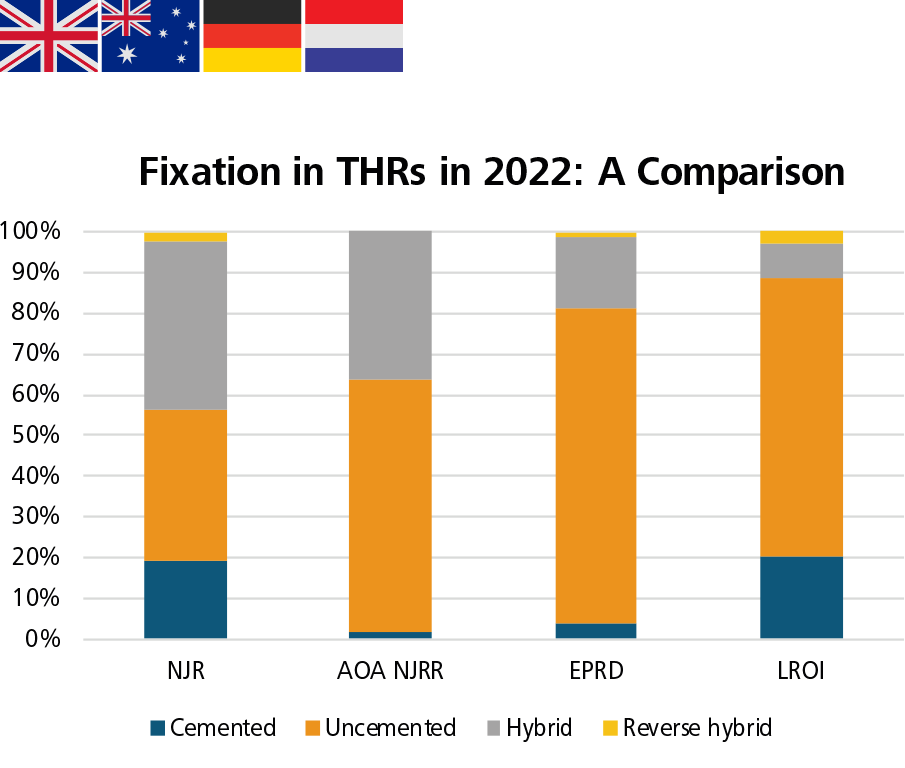
Figure 1a: Distribution of fixation methods in primary THRs in 2022 (Annual Data): in Australia, Germany, Netherlands as well as England, Wales, Northern Ireland, the Isle of Man and Guernsey.
Evaluation of the data by CeramTec is based on NJR Annual Report 2023 Page 54 Table 3.H2, AOA NJRR Annual Report 2023 Page 106 Figure HT3, EPRD Annual Report 2023 Page 30 Table 6, and LROI Annual Report 2023 Page 21 Figure Fixation. For the comparison of THR’s fixation methods, unconfirmed data and all resurfacing data were excluded when analyzing datasets from the NJR and EPRD. The usage percentage of cemented, uncemented, hybrid and reverse hybrid fixations sum up to 100%.
THRs by Femoral Head Diameter
When considering only femoral head diameters in THRs, the 32mm femoral head is the most commonly used femoral head size as reported by the European registries and NZJR, while the AOA NJRR and AJRR report a higher use of the 36mm femoral head. The EPRD, NZJR and AJRR also report a trend towards the use of 36mm femoral head.
The NJR and AOA NJRR Annual Report 2023 provide information on the size as well as the material of femoral heads used in THRs allowing for analysis of the combination. It should be mentioned that the AOA NJRR provides prosthesis-specific analysis regarding femoral head diameter restricted for modern prostheses, including mixed ceramic/mixed ceramic, and all femoral head materials (metal, ceramic, and ceramicised metal) used in combination with cross-linked polyethylene.
As in 2021, the most common head size recorded by NJR was 32mm, followed by 36mm and 28mm. According to Figure 3.H3 (e) in the Annual Report 2023, it can be observed that since 2003, there has been a transition from small head sizes (22.25mm and 26mm) in cemented hip replacements to large head sizes (>28mm) in uncemented or hybrid hip replacements can be observed since 2003. The NJR highlights that 32mm and 36mm CoP bearings are the main options for 2022.1
Among all non-XLPE bearings, femoral heads smaller than 32mm predominate. In the XLPE bearing group, the use of 32mm and >32mm femoral heads were about 2.5 times higher than that of small head sizes (<32mm), respectively. The Australian registry distinctly looks at the usage of “mixed ceramic” components (combination of alumina and zirconia) in THRs. During the period 2003-2022, 36-38mm mixed ceramic/mixed ceramic bearings accounted for approximately 73.6% of all primary THR procedures performed with this bearing surface in patients diagnosed for osteoarthritis.2
Utilization of the 32mm (47.8%) and 36mm (47.1%) heads is similar. The 32mm femoral heads have shown a downward trend in utilization, decreasing from 61.2% of all primary THRs in 2014 to 47.8% in 2022. In contrast, the use of 36mm femoral heads increased each year, from 31.4% in 2014 to 47.1% in 2022. The use of 28mm femoral heads has remained stable over the past five years, at approximately 5%.3
Since 2012, the share of 36mm heads in primary elective THRs has been on an upward trend, from 48.1% in 2012 to 62.9% in 2022, and has remained stable over the last five years. There is a corresponding decrease in the utilization of 32mm heads from 32.8% to 17.3% during this period. The volume of treatments with head sizes larger than 40mm grows slowly, from 5.5% in 2013 to 8.8% in 2022. Utilization of small heads (<28mm) remains relatively stable over time, with only 3,441 cases by 2022.4
In 2022, the most common head size in the Netherlands remains 32mm, with a utilization rate of 62%. 36mm head usage increases slightly, from 23.4% in 2020 to 27.1% in 2022. The small head size (22-28mm) shows a significant decrease in utilization from 30.7% in 2013 to 10.6% in 2022. The share of large head sizes (≥38mm) stabilizes at around 0.3%.7
In the United States, the percentage of ceramic femoral heads in THRs continues to increase from 38.4% in 2012 to 81.4% in 2022. In contrast, the AJRR reports a sustained decline in the use of CoCr femoral heads from 55.6% in 2012 to 8.4% in 2022, explaining that this trend is due to surgeons’ concerns about trunnion and taper corrosion with CoCr femoral heads. The use of ceramicised metal heads nearly doubled in 2022 (10.2%) compared to 2012 (6.1%).4
In the Netherlands, the use of ceramic femoral heads has been increasing since 2013, from 54.3% to 75.9% in 2022. Correspondingly, the use of metal femoral heads has decreased from 30.5% in 2013 to 16.6% in 2022. There is a slight upward trend in the use of ceramicized metal heads, from 5.7% in 2013 to 11.6% in 2020, but then decreasing to 7.6% in 2022.7
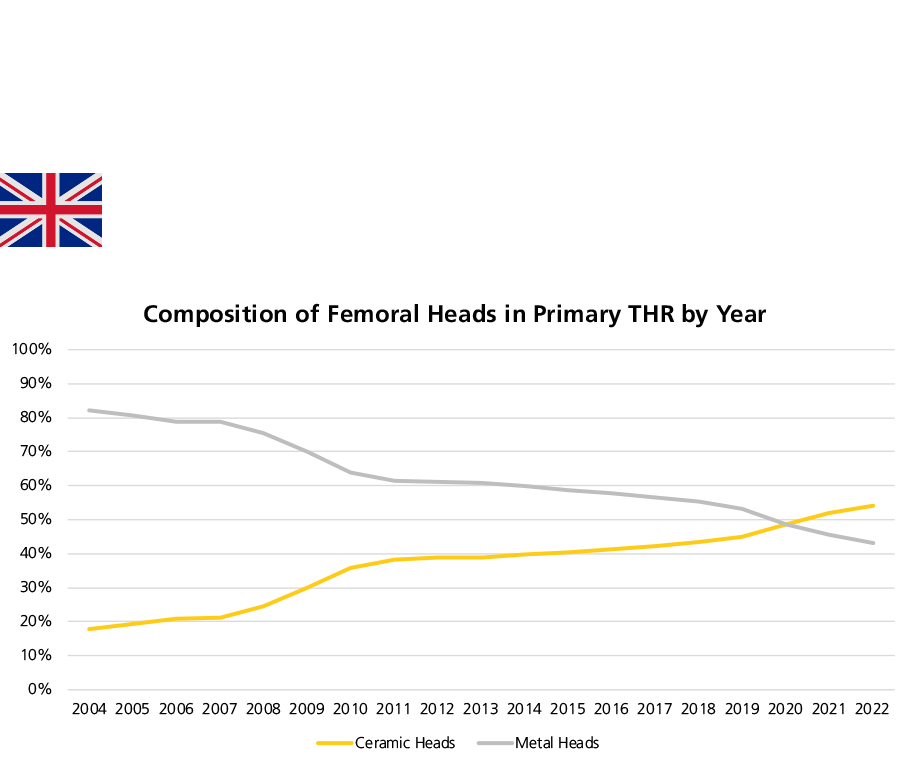
Figure 3: Composition of femoral heads in primary THRs by year in England, Wales, Northern Ireland, the Isle of Man, and Guernsey.
Evaluation of the data by CeramTec based on NJR Annual Report 2023 Page 54 Table 3.H2. The usage rates of ceramic and metal heads correspond to the sum of the usage rates of the bearings containing ceramic and metal heads, respectively. In order for the total number to be equal to the number of THRs, hip resurfacing and unconfirmed data were excluded from the percentage calculation.
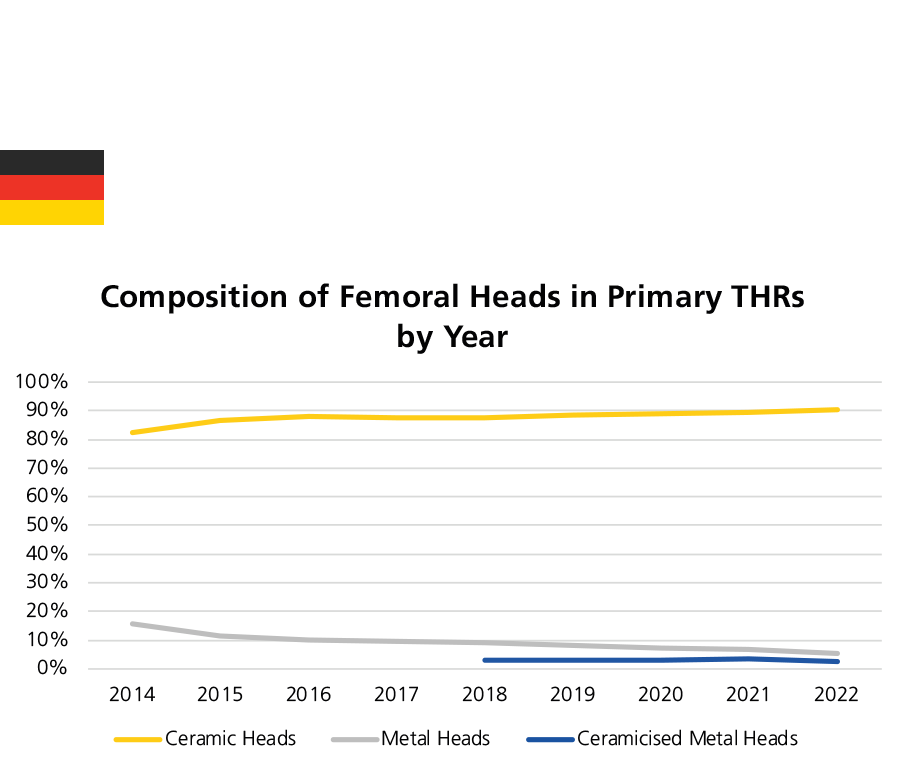
Figure 4: Composition of femoral heads in primary THRs by year in Germany.
Evaluation of the data by CeramTec based on EPRD Annual Reports 2014 to 2023 (For operation year 2014, the number indicates percentage of all primary hip replacements. For operation years 2015 to 2021, the numbers indicate percentage of all primary THRs). The usage rates of ceramic, metal and ceramicised metal heads correspond to the sum of the usage rates of the bearings containing ceramic, metal and ceramicised heads, respectively.
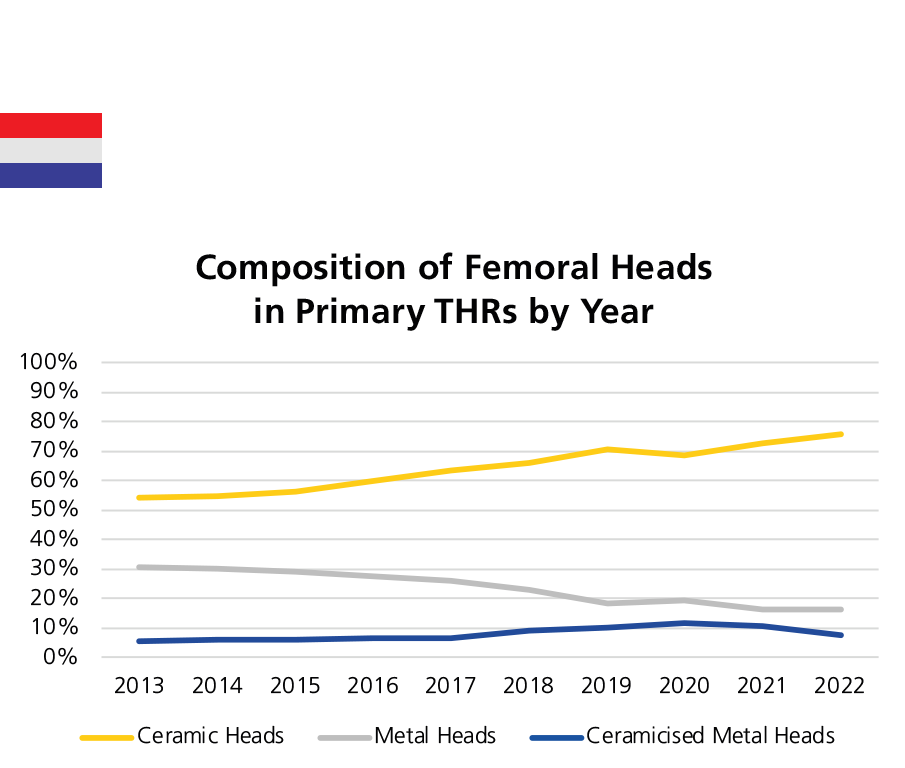
Figure 6: Composition of femoral heads in primary THRs by year in the Netherlands.
Evaluation of the data by CeramTec based on LROI Annual report 2023 Page 26 Figure Femoral head component. The usage rate of ceramic heads is equal to the percentage of Ceramics/Zo, the usage rate of metal heads is equal to the percentage of Cobalt chrome, the usage rate of Ceramicised Metal Heads is that of oxidized zirconium.
CoP bearing utilization increases from 11.4% in 2004 to 47.5% in 2021, then to 50.4% in 2022 in England, Wales, Northern Ireland, the Isle of Man and Guernsey. Correspondingly, MoP bearings utilization declines from 78.9% in 2004 to 45.6% in 2021, then to 43.1% in 2022. According to the last annual report, CoC bearings were implanted in 3.8% of all primary THRs with a known bearing type. CoP was preferred for both uncemented and hybrid hips. As in the previous two years, hybrid CoP was the most commonly implanted construct in 2022, accounting for 23% of all primary hip replacements, followed by uncemented CoP (20.3%) and hybrid MoP (15.2%).1
In Australia, almost the totality, 97.3%, of the bearings implanted in 2022 consisted of mixed ceramic- and metal-on-cross-linked polyethylene, and mixed ceramic-on-mixed ceramic, defined as "modern bearing surfaces" by the registry. The Australian registry distinctly looks at the usage of “mixed ceramic” components like BIOLOX®delta, vs. pure alumina ceramic in primary total conventional hip replacements. CoC with mixed ceramic consisted of 99.9% of all procedures with a CoC bearing. Referring to the polyethylene using in primary total conventional hip replacement, the proportion of XLPE was 97.5%. It can be observed that the use of XLPE + antioxidant increased 11.4% compared to that of 2021. The use of CoXLPE has increased during the last 10 years at the expense of CoC and MoXLPE.2
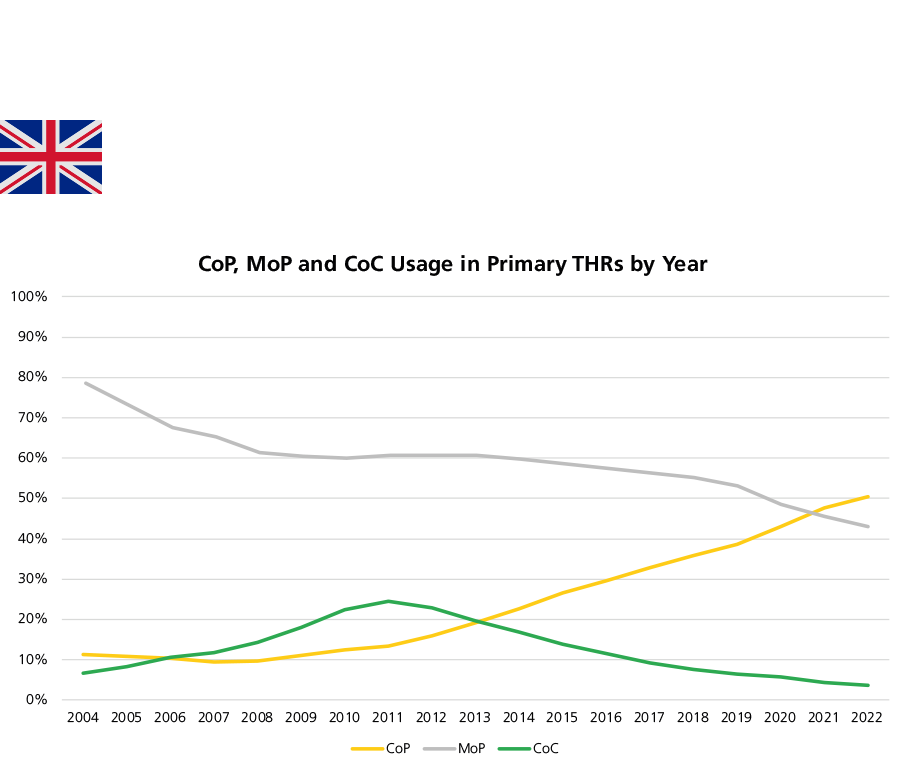
Figure 7: Usage of CoP, MoP and CoC in primary THRs by year in England, Wales, Northern Ireland, the Isle of Man and Guernsey.
Evaluation of the data by CeramTec based on the NJR Annual Report 2023 Page 54 Table 3.H2. The usage rates of CoP, MoP and CoC correspond to the sum of the usage rates of CoP, MoP and CoC bearings with different fixation methods, respectively. In order for the total number to be equal to the number of THRs, hip resurfacing and unconfirmed data were excluded from the percentage calculation.
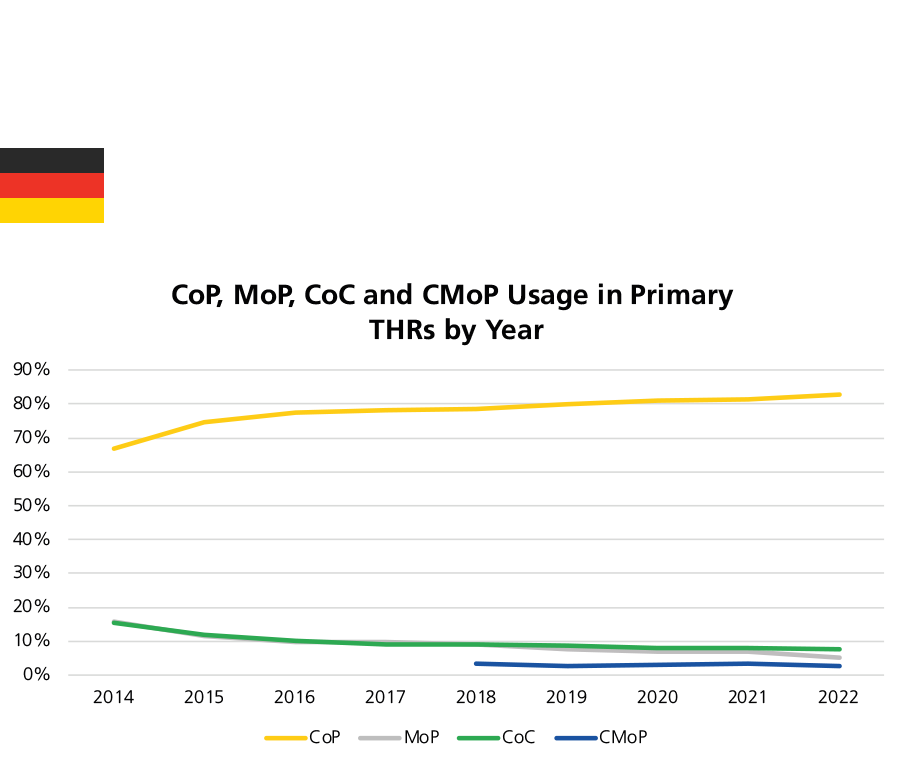
Figure 8: Usage of CoP, MoP, CoC and CMoP in primary THRs by year in Germany.
Evaluation of the data by CeramTec based on the EPRD Annual Reports 2014 to 2023 (For operation year 2014, the number indicates percentage of all primary hip replacements. For operation years 2015 to 2022, the numbers indicate percentage of all primary THRs). The usage rates of CoP, MoP and CMoP correspond to the sum of the usage rates of bearings containing ceramic, metal and ceramicised metal heads in conjunction with different polyethylene types, respectively.
Before 2013, dual mobility was rarely used. From 2014 to the present, the use of dual mobility has steadily increased, especially in hybrid fixation group. The use of dual mobility with a metal head and with a ceramic head account for 2.76% of all primary THRs, compared to 2.46% in 2021. The use of dual mobility with a metal head (MoPoM) increased from 1.54% in 2021 to 1.63% in 2022, while with a ceramic head (CoPoM) increased from 0.92% in 2021 to 1.12% in 2022.1
EPRD included dual mobility bearing couples for the first time in its 2019 Annual Report analysis. In 2022, this implant type accounted for 1.9% of all bearings in primary THRs, the same as in 2021, while in acetabular revisions, dual-mobility cups were chosen in 38.5% of cases, increasing from 10% in 2014 to 38.5% in 2022.3
In the United States, the use of dual mobility in primary and revision hip arthroplasty has continued to increase since 2012. However, after relatively stable usage rate over last three years, the use of dual mobility has declined slightly to 7.6% in 2022, from 8.8% in 2021. The registry considered this decline may be due to misclassifying dual mobility constructs as 28mm heads. This construct was most commonly used in the oldest (≥90) and youngest (<50 years) patient groups. The use of dual mobility has increased annually for hip revision due to dislocation/instability, from 12.9% in 2012 to 34.3% in 2022.4
In the Netherlands, dual mobility cup is used in 5.2% of all primary THRs in 2022, up from 1.4% in 2013. This type of acetabular cup is mainly used for hip revision surgeries in Netherlands, accounting for 48.1% of all hip revision surgeries in 2022, increasing from 32.2% in 2013 to 54% in 2021, then decreasing to 48.1% in 2022.7

Figure 11: Annual use of dual mobility bearings in primary THRs in the NJR, AJRR, EPRD, and LROI.
Evaluation of the data by CeramTec based on the NJR Annual Report 2023 Page 54 Table 3.H2, EPRD Annual Report 2019 to 2023, and AJRR Annual Report 2023 Page 39 Figure 2.18, LROI Annual Report 2023 Page 23 Figure Dual mobility. For the data from the NJR, the usage rates of dual mobility correspond to the sum of the usage rates of dual mobility bearings with different fixation methods. In order for the total number to be equal to the number of THRs, all data relating to hip resurfacing were excluded from the percentage calculation.
AJRR: The American Joint Replacement Registry
AOA NJRR: The Australian Orthopaedic Association National Joint Replacement Registry
CI: Confidence Interval
CMoP: Ceramicised Metal-on-Polyethylene
CoC: Ceramic-on-Ceramic
CoM: Ceramic-on-Metal
CoP: Ceramic-on-Polyethylene (including both conventional polyethylene and cross-linked polyethylene)
CoPoM: Ceramic-on-Polyethylene-on-Metal (Dual Mobility - only used by the NJR)
CoXLPE: Ceramic-on-Cross-Linked Polyethylene
CohXLPE: Ceramic-on-Highly Cross-Linked Polyethylene (only used by the EPRD)
DM: Dual Mobility
EPRD: Endoprothesenregister Deutschland (The German Arthroplasty Registry)
EQ-5D: European Quality of Life 5 Dimensions
EQ-5D-5L: European Quality of Life 5 Dimensions 5 Level Version
EQ VAS Health: EuroQol-Visual Analogue Scales
HOOS JR. Score: Hip Disability and Osteoarthritis Outcome Score for Joint Replacement Score
HR: Hazard Ratio
ISAR: International Society of Arthroplasty Registries
MoM: Metal-on-Metal
MoP: Metal-on-Polyethylene (including both conventional polyethylene and cross-linked polyethylene)
MoPoM: Metal-on-Polyethylene-on-Metal (Dual Mobility - only used by the NJR)
MoXLPE: Metal-on-Cross-Linked Polyethylene
MohXLPE: Metal-on-Highly Cross-Linked Polyethylene (only used by the EPRD)
NHS: The National Health Service
NJR: The National Joint Registry, which covers England, Wales, Northern Ireland, the Isle of Man and the States
of Guernsey
NZJR: The New Zealand Joint Registry
OA: Osteoarthritis
PROMs: Patient-Reported Outcome Measures
PROMIS-10: Patient-Reported Outcomes Measurement Information System-10
SAR: The Swedish Arthroplasty Register (Merger of the Swedish Hip Arthroplasty Register and the Swedish Knee Arthroplasty Register)
SD: Standard Deviation
THA: Total Hip Arthroplasty
THR: Total Hip Replacement
VR-12: The Veterans RAND 12 Item Health Survey
Figure 1a: Distribution of fixation methods in primary THRs in 2022 (Annual Data): in Australia, Germany, Netherlands as well as England, Wales, Northern Ireland, the Isle of Man and Guernsey.
Figure 1b: Distribution of femoral stem fixation methods in primary THRs (2012-2022) in the USA.
Figure 2a: Distribution of head sizes in primary THRs in 2022 (Annual Data): in Germany and Netherlands.
Figure 2b: Total Percentage of head sizes in primary THRs: in the United States and Netherlands.
Figure 3: Composition of femoral heads in primary THRS by year in England, Wales, Northern Ireland, the Isle of Man and Guernsey.
Figure 4: Composition of femoral heads in primary THRs by year in Germany.
Figure 5: Composition of femoral heads in primary THRs (2012-2022) in the United States.
Figure 6: Composition of femoral heads in primary THRs by year in the Netherlands.
Figure 7: Usage of CoP, MoP and CoC in primary THRs by year in England, Wales, Northern Ireland, the Isle of Man and Guernsey.
Figure 8: Usage of CoP, MoP, CoC and CMoP in primary THRs by year in Germany.
Figure 9: Usage of CoP, MoP and CMoP in primary THRs by year in the United States.
Figure 10: Usage of CoP, MoP, CoC and CMoP in primary THRs by year in the Netherlands.
Figure 11: Annual use of dual mobility bearings in primary THRs in the NJR, AJRR, EPRD, and LROI.
Table 1: General information of national joint registries.
References
National Joint Registry. 20th Annual Report 2023. Surgical data to 31 December 2022. ISSN 2054-183X (Online). 2023:1-370.
Smith PN, Gill DR, McAuliffe MJ, McDougall C, Stoney JD, Vertullo CJ, Wall CJ, Corfield S, Page R, Cuthbert AR, Du P, Harries D, Holder C, Lorimer MF, Cashman K, Lewis PL. Hip, Knee and Shoulder Arthroplasty: 2023 Annual Report, Australian Orthopaedic Association National Joint Replacement Registry, AOA: Adelaide, South Australia. 2023. https://doi.org/10.25310/YWQZ9375
Endoprothesenregister Deutschland (EPRD). Jahresbericht 2023. Mit Sicherheit mehr Qualität. ISBN: 978-3-949872-02-0. 2023:1-196.
American Academy of Orthopaedic Surgeons (AAOS). American Joint Replacement Registry (AJRR): 2023 Annual Report. ISSN 2375-9119 (Online). 2023: 1-125.
The New Zealand Joint Registry. Twenty-four Year Report January 1999 to December 2022. 2023:1-211.
Swedish Arthroplasty Register. Annual report 2023. ISSN 16454-5982. 2023: 1-310.
Dutch Arthroplasty Register (LROI). Online LROI annual report 2023. Joint arthroplasty data to 31 December 2022. 2023: 1-249.
Endoprothesenregister Deutschland (EPRD). Statusbericht 2014 Mit Sicherheit mehr Qualität. 2015: 1-60.
Endoprothesenregister Deutschland (EPRD). Jahresbericht 2015 Mit Sicherheit mehr Qualität. ISBN: 978-3-9817673-1-5. 2016: 1-65.
Endoprothesenregister Deutschland (EPRD). Jahresbericht 2016 Mit Sicherheit mehr Qualität. 2017: 1-64.
Endoprothesenregister Deutschland (EPRD). Jahresbericht 2017 Mit Sicherheit mehr Qualität. ISBN: 978-3-9817673-3-9. 2018: 1-80.
German Arthroplasty Registry (EPRD). 2019 Annual Report. 2020: 1-125. doi:10.36186/reporteprd01202.
Endoprothesenregister Deutschland (EPRD). Jahresbericht 2020 Mit Sicherheit mehr Qualität. 2020: 1-128. doi:10.36186/reporteprd022020.
Endoprothesenregister Deutschland (EPRD). Jahresbericht 2021 Mit Sicherheit mehr Qualität. ISBN: 978-3-9817673-9-1 2021: 1-193.
Endoprothesenregister Deutschland (EPRD). Jahresbericht 2022. Mit Sicherheit mehr Qualität. ISBN: 978-3-949872-00-6 2022:1-175.

